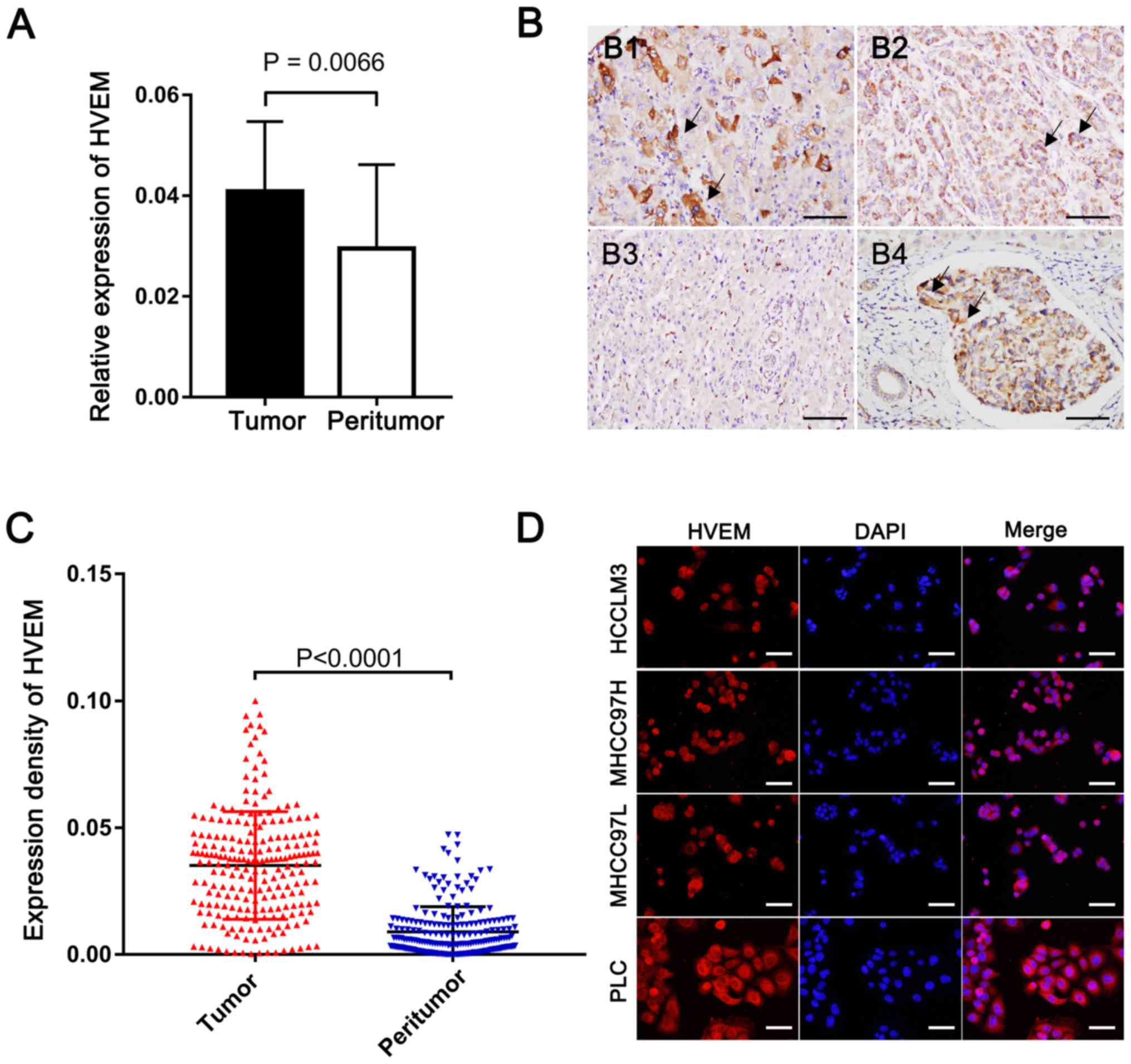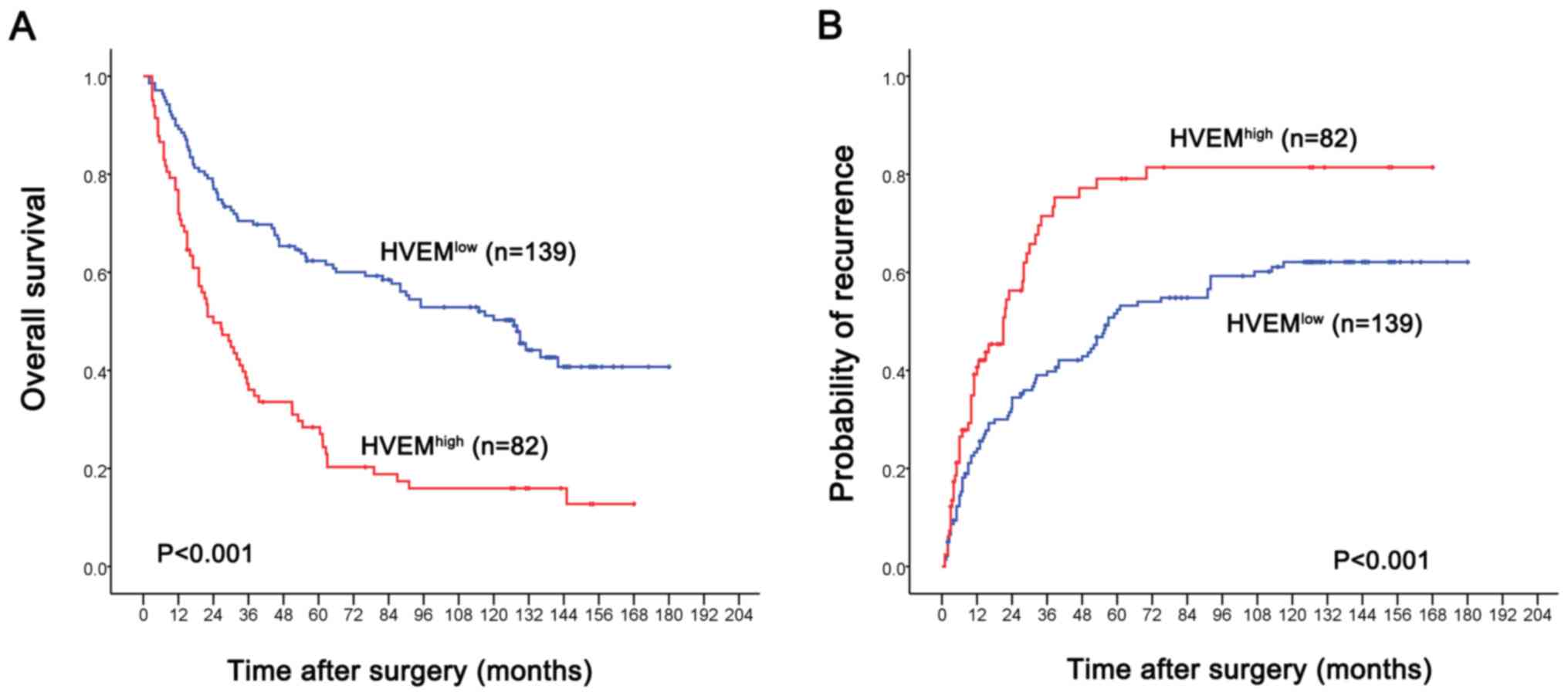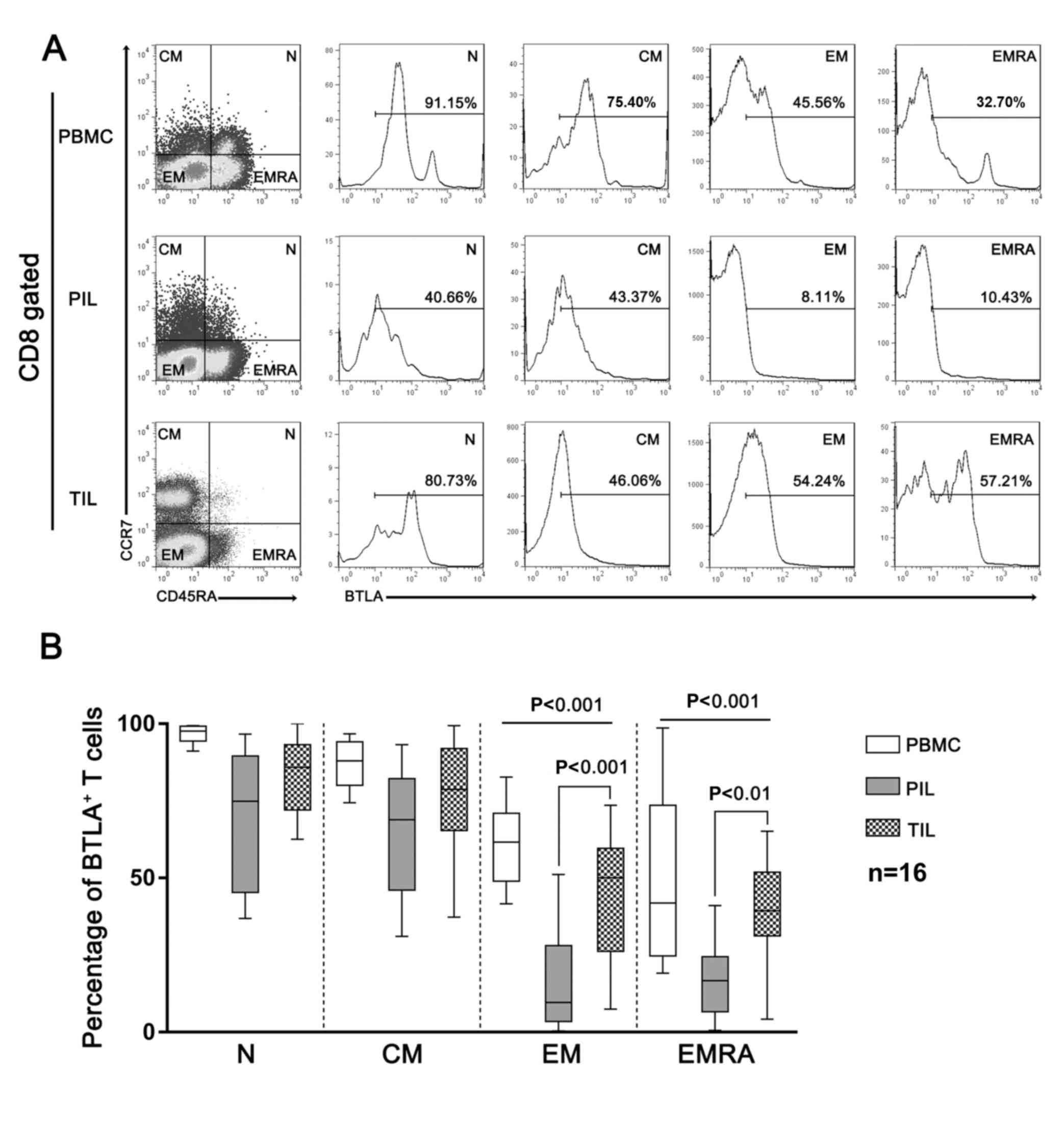|
1
|
Bray F, Ferlay J, Soerjomataram I, Siegel
RL, Torre LA and Jemal A: Global cancer statistics 2018: GLOBOCAN
estimates of incidence and mortality worldwide for 36 cancers in
185 countries. CA Cancer J Clin. 68:394–424. 2018. View Article : Google Scholar : PubMed/NCBI
|
|
2
|
Villanueva A: Hepatocellular carcinoma. N
Engl J Med. 380:1450–1462. 2019. View Article : Google Scholar : PubMed/NCBI
|
|
3
|
Greten TF and Sangro B: Targets for
immunotherapy of liver cancer. J Hepatol. Sep 18–2017.(Epub ahead
of print).
|
|
4
|
Okusaka T and Ikeda M: Immunotherapy for
hepatocellular carcinoma: Current status and future perspectives.
ESMO Open. 3 (Suppl 1):e0004552018. View Article : Google Scholar : PubMed/NCBI
|
|
5
|
Cheung TC, Humphreys IR, Potter KG, Norris
PS, Shumway HM, Tran BR, Patterson G, Jean-Jacques R, Yoon M, Spear
PG, et al: Evolutionarily divergent herpesviruses modulate T cell
activation by targeting the herpesvirus entry mediator cosignaling
pathway. Proc Natl Acad Sci USA. 102:13218–13223. 2005. View Article : Google Scholar : PubMed/NCBI
|
|
6
|
Cai G and Freeman GJ: The CD160, BTLA,
LIGHT/HVEM pathway: A bidirectional switch regulating T-cell
activation. Immunol Rev. 229:244–258. 2009. View Article : Google Scholar : PubMed/NCBI
|
|
7
|
Yu X, Zheng Y, Mao R, Su Z and Zhang J:
BTLA/HVEM signaling: Milestones in research and role in chronic
hepatitis B virus infection. Front Immunol. 10:6172019. View Article : Google Scholar : PubMed/NCBI
|
|
8
|
Rodriguez-Barbosa JI, Schneider P, Weigert
A, Lee KM, Kim TJ, Perez-Simon JA and Del Rio ML: HVEM, a
cosignaling molecular switch, and its interactions with BTLA, CD160
and LIGHT. Cell Mol Immunol. 16:679–682. 2019. View Article : Google Scholar : PubMed/NCBI
|
|
9
|
del Rio ML, Lucas CL, Buhler L, Rayat G
and Rodriguez-Barbosa JI: HVEM/LIGHT/BTLA/CD160 cosignaling
pathways as targets for immune regulation. J Leukoc Biol.
87:223–235. 2010. View Article : Google Scholar : PubMed/NCBI
|
|
10
|
Wang Y, Subudhi SK, Anders RA, Lo J, Sun
Y, Blink S, Wang Y, Wang J, Liu X, Mink K, et al: The role of
herpesvirus entry mediator as a negative regulator of T
cell-mediated responses. J Clin Invest. 115:711–717. 2005.
View Article : Google Scholar : PubMed/NCBI
|
|
11
|
Croft M, Duan W, Choi H, Eun SY, Madireddi
S and Mehta A: TNF superfamily in inflammatory disease: Translating
basic insights. Trends Immunol. 33:144–152. 2012. View Article : Google Scholar : PubMed/NCBI
|
|
12
|
Shui JW, Steinberg MW and Kronenberg M:
Regulation of inflammation, autoimmunity, and infection immunity by
HVEM-BTLA signaling. J Leukoc Biol. 89:517–523. 2011. View Article : Google Scholar : PubMed/NCBI
|
|
13
|
Migita K, Sho M, Shimada K, Yasuda S,
Yamato I, Takayama T, Matsumoto S, Wakatsuki K, Hotta K, Tanaka T,
et al: Significant involvement of herpesvirus entry mediator in
human esophageal squamous cell carcinoma. Cancer. 120:808–817.
2014. View Article : Google Scholar : PubMed/NCBI
|
|
14
|
Hokuto D, Sho M, Yamato I, Yasuda S, Obara
S, Nomi T and Nakajima Y: Clinical impact of herpesvirus entry
mediator expression in human hepatocellular carcinoma. Eur J
Cancer. 51:157–165. 2015. View Article : Google Scholar : PubMed/NCBI
|
|
15
|
Han L, Wang W, Lu J, Kong F, Ma G, Zhu Y,
Zhao D, Zhu J, Shuai W, Zhou Q, et al: AAV-sBTLA facilitates HSP70
vaccine-triggered prophylactic antitumor immunity against a murine
melanoma pulmonary metastasis model in vivo. Cancer Lett.
354:398–406. 2014. View Article : Google Scholar : PubMed/NCBI
|
|
16
|
Yi Y, He HW, Wang JX, Cai XY, Li YW, Zhou
J, Cheng YF, Jin JJ, Fan J and Qiu SJ: The functional impairment of
HCC-infiltrating γδ T cells, partially mediated by regulatory T
cells in a TGFβ- and IL-10-dependent manner. J Hepatol. 58:977–983.
2013. View Article : Google Scholar : PubMed/NCBI
|
|
17
|
Yi Y, Wu H, Gao Q, He HW, Li YW, Cai XY,
Wang JX, Zhou J, Cheng YF, Jin JJ, et al: Interferon regulatory
factor (IRF)-1 and IRF-2 are associated with prognosis and tumor
invasion in HCC. Ann Surg Oncol. 20:267–276. 2013. View Article : Google Scholar : PubMed/NCBI
|
|
18
|
Livak KJ and Schmittgen TD: Analysis of
relative gene expression data using real-time quantitative PCR and
the 2(-Delta Delta C(T)) method. Methods. 25:402–408. 2001.
View Article : Google Scholar : PubMed/NCBI
|
|
19
|
Li Y, Tang Y, Ye L, Liu B, Liu K, Chen J
and Xue Q: Establishment of a hepatocellular carcinoma cell line
with unique metastatic characteristics through in vivo selection
and screening for metastasis-related genes through cDNA microarray.
J Cancer Res Clin Oncol. 129:43–51. 2003. View Article : Google Scholar : PubMed/NCBI
|
|
20
|
Li Y, Tian B, Yang J, Zhao L, Wu X, Ye SL,
Liu YK and Tang ZY: Stepwise metastatic human hepatocellular
carcinoma cell model system with multiple metastatic potentials
established through consecutive in vivo selection and studies on
metastatic characteristics. J Cancer Res Clin Oncol. 130:460–468.
2004. View Article : Google Scholar : PubMed/NCBI
|
|
21
|
Song J, Ge Z, Yang X, Luo Q, Wang C, You
H, Ge T, Deng Y, Lin H, Cui Y, et al: Hepatic stellate cells
activated by acidic tumor microenvironment promote the metastasis
of hepatocellular carcinoma via osteopontin. Cancer Lett.
356:713–720. 2015. View Article : Google Scholar : PubMed/NCBI
|
|
22
|
Beldi G, Wu Y, Banz Y, Nowak M, Miller L,
Enjyoji K, Haschemi A, Yegutkin GG, Candinas D, Exley M and Robson
MC: Natural killer T cell dysfunction in CD39-null mice protects
against concanavalin A-induced hepatitis. Hepatology. 48:841–852.
2008. View Article : Google Scholar : PubMed/NCBI
|
|
23
|
Ren S, Tian Q, Amar N, Yu H, Rivard CJ,
Caldwell C, Ng TL, Tu M, Liu Y, Gao D, et al: The immune
checkpoint, HVEM may contribute to immune escape in non-small cell
lung cancer lacking PD-L1 expression. Lung Cancer. 125:115–120.
2018. View Article : Google Scholar : PubMed/NCBI
|
|
24
|
Sine H, Marco D and Straten PT: Effector
CD4 and CD8 T cells and their role in the tumor microenvironment.
Cancer Microenviron. 6:123–133. 2013. View Article : Google Scholar : PubMed/NCBI
|
|
25
|
Marin-Acevedo JA, Dholaria B, Soyano AE,
Knutson KL, Chumsri S and Lou Y: Next generation of immune
checkpoint therapy in cancer: New developments and challenges. J
Hematol Oncol. 11:392018. View Article : Google Scholar : PubMed/NCBI
|
|
26
|
Zhao Q, Huang ZL, He M, Gao Z and Kuang
DM: BTLA identifies dysfunctional PD-1-expressing CD4+ T
cells in human hepatocellular carcinoma. Oncoimmunology.
5:e12548552016. View Article : Google Scholar : PubMed/NCBI
|
|
27
|
Cheng AL, Hsu C, Chan SL, Choo SP and Kudo
M: Challenges of combination therapy with immune checkpoint
inhibitors for hepatocellular carcinoma. J Hepatol. 72:307–319.
2020. View Article : Google Scholar : PubMed/NCBI
|
|
28
|
Darvin P, Toor SM, Sasidharan Nair V and
Elkord E: Immune checkpoint inhibitors: Recent progress and
potential biomarkers. Exp Mol Med. 50:1–11. 2018. View Article : Google Scholar : PubMed/NCBI
|
|
29
|
Zhu AX, Finn RS, Edeline J, Cattan S,
Ogasawara S, Palmer D, Verslype C, Zagonel V, Fartoux L, Vogel A,
et al: Pembrolizumab in patients with advanced hepatocellular
carcinoma previously treated with sorafenib (KEYNOTE-224): A
non-randomised, open-label phase 2 trial. Lancet Oncol. 19:940–952.
2018. View Article : Google Scholar : PubMed/NCBI
|
|
30
|
Fourcade J, Sun Z, Pagliano O, Guillaume
P, Luescher IF, Sander C, Kirkwood JM, Olive D, Kuchroo V and
Zarour HM: CD8(+) T cells specific for tumor antigens can be
rendered dysfunctional by the tumor microenvironment through
upregulation of the inhibitory receptors BTLA and PD-1. Cancer Res.
72:887–896. 2012. View Article : Google Scholar : PubMed/NCBI
|
|
31
|
Grabmeier-Pfistershammer K, Stecher C,
Zettl M, Rosskopf S, Rieger A, Zlabinger GJ and Steinberger P:
Antibodies targeting BTLA or TIM-3 enhance HIV-1 specific T cell
responses in combination with PD-1 blockade. Clin Immunol.
183:167–173. 2017. View Article : Google Scholar : PubMed/NCBI
|
|
32
|
Stecher C, Battin C, Leitner J, Zettl M,
Grabmeier-Pfistershammer K, Höller C, Zlabinger GJ and Steinberger
P: PD-1 blockade promotes emerging checkpoint inhibitors in
enhancing T cell responses to allogeneic dendritic cells. Front
Immunol. 8:5722017. View Article : Google Scholar : PubMed/NCBI
|
|
33
|
Liu J, Li J, He M, Zhang GL and Zhao Q:
Distinct changes of BTLA and HVEM expressions in circulating
CD4+ and CD8+ T cells in hepatocellular
carcinoma patients. J Immunol Res. 2018:45615712018. View Article : Google Scholar : PubMed/NCBI
|
|
34
|
Inoue T, Sho M, Yasuda S, Nishiwada S,
Nakamura S, Ueda T, Nishigori N, Kawasaki K, Obara S, Nakamoto T,
et al: HVEM expression contributes to tumor progression and
prognosis in human colorectal cancer. Anticancer Res. 35:1361–1367.
2015.PubMed/NCBI
|
|
35
|
Lan X, Li S, Gao H, Nanding A, Quan L,
Yang C, Ding S and Xue Y: Increased BTLA and HVEM in gastric cancer
are associated with progression and poor prognosis. Onco Targets
Ther. 10:919–926. 2017. View Article : Google Scholar : PubMed/NCBI
|
|
36
|
Tao R, Wang L, Murphy KM, Fraser CC and
Hancock WW: Regulatory T cell expression of herpesvirus entry
mediator suppresses the function of B and T lymphocyte
attenuator-positive effector T cells. J Immunol. 180:6649–6655.
2008. View Article : Google Scholar : PubMed/NCBI
|
|
37
|
Derré L, Rivals JP, Jandus C, Pastor S,
Rimoldi D, Romero P, Michielin O, Olive D and Speiser DE: BTLA
mediates inhibition of human tumor-specific CD8+ T cells that can
be partially reversed by vaccination. J Clin Invest. 120:157–167.
2010. View Article : Google Scholar : PubMed/NCBI
|
|
38
|
Haymaker CL, Wu RC, Ritthipichai K,
Bernatchez C, Forget MA, Chen JQ, Liu H, Wang E, Marincola F, Hwu P
and Radvanyi LG: BTLA marks a less-differentiated
tumor-infiltrating lymphocyte subset in melanoma with enhanced
survival properties. Oncoimmunology. 4:e10142462015. View Article : Google Scholar : PubMed/NCBI
|
|
39
|
Martins-Filho SN, Paiva C, Azevedo RS and
Alves VAF: Histological grading of hepatocellular carcinoma-a
systematic review of literature. Front Med (Lausanne). 4:1932017.
View Article : Google Scholar : PubMed/NCBI
|
|
40
|
Minagawa M, Ikai I, Matsuyama Y, Yamaoka Y
and Makuuchi M: Staging of hepatocellular carcinoma: Assessment of
the Japanese TNM and AJCC/UICC TNM systems in a cohort of 13,772
patients in Japan. Ann Surg. 245:909–922. 2007. View Article : Google Scholar : PubMed/NCBI
|
|
41
|
Forner A, Reig ME, de Lope CR and Bruix J:
Current strategy for staging and treatment: The BCLC update and
future prospects. Semin Liver Dis. 30:61–74. 2010. View Article : Google Scholar : PubMed/NCBI
|

















